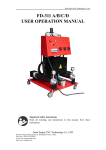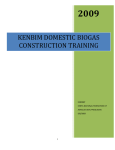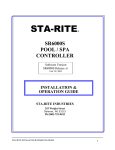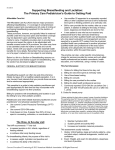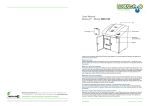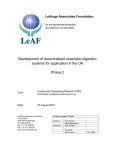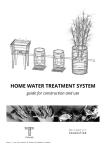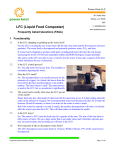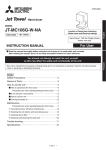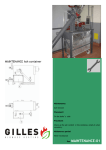Download KENBIM BIOGAS USER MANUAL
Transcript
KENBIM BIOGAS USER MANUAL KENYA NATIONAL DOMESTIC BIOGAS PROGRAMME (KENDBIP) 1.0 BIOGAS TECHNOLOGY Biogas is the gas generated when bacteria degrade biological materials in the absence of oxygen, in a process known as anaerobic digestion. Biogas is a mixture of methane (also known as marsh gas or natural gas, CH4) and carbon dioxide. It is a renewable fuel which has for a long while (time) been produced from organic waste treatment. Cow dung + urine/water Anaerobic digestion process Biogas Liquid overflow Bio-slurry Post treatment Energy Plants 2.0 GENERAL OPERATION AND MAINTENANCE. 1. Ensure the feed material is homogeneous (thoroughly mixed with water) preferably at 1:1 ratio, before releasing into the digester. This will reduce the chances of settling substances along the inlet flow line. 2. Ensure the particles are as tiny as possible to increase the surface area for bacterial action. (This may imply crushing of lumps and other huge particles) or use of soft dung which has not been left to dry for a long time. 3. Antiseptics, pesticides and detergents should be avoided at all costs. 4. Non-digestible materials should be avoided during feeding of the plant hence there should be proper selection when using other different feeds for the digester apart from cow dung. 5. Fittings and other accessories should be well fitted to avoid leakages. (Gas outlet, water traps and valves should be occasionally checked for leakages). 6. Clean the overflow once in two weeks time to avoid blockage of the expansion chamber. 7. After using stove, valve must be closed and switch on the stove must be turned off. If only valve is closed it may cause rust on the switch. Grease the switch occasionally, and do not let it dry. Change a new switch when damaged as stove has been long used-Collins is this clear? 2.1 General Rules in Bio-gas Uses In a new chamber, gas produced after animal dung has been first added must be vented as it cannot be used. It should be vented 2-3 times or until gas becomes flammable. Use manometer to check magnitude before using gas. Pressure should be at 10-80 cm. Do not leave valve opened when not in use. If pipe or hose is damaged, gas may leak and cause a fire. Light should be lit closely at the head of burner before opening the valve. If the valve is opened first, gas may come out exceedingly and is dangerous. Do not use igniter to lighten the stove because bio-gas is a slowly flammable passive gas. Close valve immediately and open windows and doors for ventilation. Do not fire until there is no more gas leaking. 3.0 THE BIOGAS PLANT A complete unit of this KENBIM biogas plant contains the following: • Digester Expansion chamber Digester Inlet / Mixing Chamber • • Expansion chamber unit Gas piping • Accessories depending on the size of the plant installed To the Kitchen 3.1 Burner Biogas Stoves Biogas Lamps Always clean the burner by removing the head burner and pushing through the holes with a sharp wooden stick, wire or nail so that gas will flow out easily. Use a wire brush to get rid of sediment. Later scrub the rust or dirtiness out. For a stove with built-in cooking vessel built into the stove, remove the tray under the stove to clean. When stove is being used, open valve in the kitchen first and set fire prepared at burner then turn on the switch of stove last. Flame should come out from each hole of the burner head evenly, pale blue flame indicates clean burner but red flame indicates presence of sediment. 3.2 Bio-gas Plant and Agriculture Cycle System Three main cycle components as in full agriculture system are crop farming, bio-gas plant and animal products. Each provides direct economic benefit to agriculture. Biogas - Provides energy to household uses -Provides organic fertilizer to improve the soil or for merchandise. 4.0 FEEDING Size in cubic meters 4 6 8 10 12 Dung in kilos 30 45 60 90 100 Water in liters 30 45 60 90 100 a) Mixing: the water and dung mixture should be in the ration of 1:1.Stirring should be done well to help in mixing the manure with the water. Proper mixing determines the functionality of the digester and production of the gas. b) NB: During the rainy season, the right slurry density should be attained. c) Animal excrement: daily quantity of dung added must be sufficient, if too much or too little is added, very little or no gas will be produced as the bacteria does not have sufficient time to break down the manure. d) Temperature: the effective temperature for bacteria to grow is 370 C. If higher or lower than the suggested the bacteria will not develop, decreasing gas production. The digester should not be constructed under tree shades. e) PH Balance: A pH between 7-8.5 is optimal. If below the suggested pH, gas will not be produced. Ensure that the substrate fed is not too acidic or too basic. 4.1 Mixing Chamber Maintenance All hay, husks, grass, gravel, soil, sand or non-organic materials must be removed from animal excrement when mixed with water, before releasing it into the mixing chamber. Those materials will shallow the level of the digester chamber and cause blockage in pipes. Mix or stir the mixture in the inlet pit until it becomes liquid, then open the gate of the mixing chamber to let the mixture flow into the digester chamber. Clean mixing chamber and gate at every addition of the excrement in the digester chamber. Use wooden stick/Hands to stir the fermented liquid from the expansion chamber opening if necessary once a week to avoid the formation of crust or scum at the bottom of the chamber or blockage of the inlet pipe. NB: before adding of excrement gas should be partly released for usage to let manure flow easily in to the digester chamber, as high pressure in the digester chamber would slow down the flow of the manure 4.2 Expansion Chamber Maintenance Keep the outlet pipe free from blockage by clearing the dry manure or residue around the edge of the outlet pipe to let the manure flow freely. Close the lid of the expansion chamber to prevent animals or rainwater to fall in. At least once a week the inside of the chamber should be pushed and stirred with wooden stick to prevent crust or scum formed to block the pipe and the residue from forming at the bottom floor. 4.3 Storage Tank and Compost pit Maintenance Do not leave the substrate overflow from storage tank as it is unsightly and dirty. The substrate should be removed from storage tank and sand bed filter regularly to prevent the over filling and the flow of substrate back into the digester chamber. Use the substrate in the agricultural fields or store it for merchandise. Substrate in the storage tank can be used as liquid slurry form or mixed with cutting weeds as fermented fertilizer or dried for usage or as dried fertilizer for sale. 4.4 Water Trap Maintenance • Water trap should be opened every two weeks without opening the valve at the inlet of the chamber to let the risen water flow out. Close the trap tightly to avoid the water from stopping the flow of gas. • Water trap pit should be covered to avoid trash, leaves and rain which will cause problem or rust at the valve. • Valve has to be changed or repaired immediately if there is any damage. Water Trap 4.5 Manometers Manometer is an important instrument in bio-gas system. It indicates any malfunction in bio-gas system. Both water levels in mono-meter should be the same (when gas is emptied). To calculate the exact quantity of gas stored, adjust the level as follows : Close the valve at the inlet of digester chamber. Open valve at water trap 100 cm Water column Fill water at the end of the pipe until both levels are at 0. 4.6 Gas Pipe Maintenance Gas pipe should be installed against the wall or post and secure tightly. The pipe will be broken easily if installed independently or loosely. Underground gas pipe should be covered safely to prevent the damage caused by animals, humans or vehicles. Rubber hose should be checked every month for any water. Valve should be closed and hose emptied if there is water trapped inside. Hose clamp must be tightened after replacing the hose. 5.0 POTENTIAL PROBLEMS AND LIKELY SOLUTIONS IN A BIOGAS DIGESTER Problem Possible cause Insufficient gas pressure, - Gas leakage along the pipe maximum plant pressure line not reached - Under feeding of the plant. Remedy/Solution: - Check for any gas leakage and solve the problem, - Follow the feeding instruction carefully Gas production has declined - Underfeeding of the plant, - Ensure the feeding instruction is and is less than before - Leakages through gas tight followed and daily feeding is done zone, for a constant gas production, - Possible gas leakages along - Check for gas leakages and gas the gas pipe line, - Scum formation inside the digester, - Dung/water mixture not at the right proportion to the one incorporated in the digester design, - Accumulation of inorganic solids inside the digester. - Over feeding of the digester, Bio-effluent smelling at the expansion chamber & slurry canal Gas stove not burning well - Blocked primary air ducts, - Blocked flame holes, tightness inside the plant, when necessary emptying of the plant should be performed in order to inspect and solve the problem. - Follow feeding instruction to ensure a good consistency of the mixture - Clean all the air ducts and burner holes regularly to prevent blockages, - Incorrect gas/air mixing ratio - Adjust the primary air knob in order to get the right mixture, - Open the water drain valve to remove any water condensed inside. - Poor stove design - Purchase better stove - Dirt glass screen, - Clean the lamp glass screen - Cracked or destroyed mantle, regularly, - Incorrect gas/air mixing ratio - Replace the cracked mantle, - Presence of water in the - Adjust the primary air knob in system order to get the right mixture, - Blockage of the mantle holder - Open water drain valve to hole remove any water. - Clean the mantle holder hole - Under feeding or irregular - Ensure that daily feeding is done feeding in sufficient quantity - Ensure that mixing is done properly and all - Scum formation inside the the unwanted material are digester removed - Empty the plant, remove the scum and stir the inside slurry - Presence of water in the pipe line, The lamp does not give bright light Maximum gas pressure achieved but still gas quantity is not as expected No gas reaching the appliances - Water has blocked the gas passage along the pipe line - No any gas being produced inside the digester - Disconnected gas pipe line - Closed main gas valve at the test unit chamber. - Inhibiting substances have entered into the digester The feeding materials are not entering into the digester Bio-effluent too thick at the expansion chamber/overflow point - Blocked inlet pipe - Position of the inlet mixing chamber l d b dung/water l h fl - Incorrect mixing ratio (less water/urine), - No hydraulic movement inside the digester, - Water leakage at the expansion chamber base - Water leakage on the lower part of the digester, Slurry entering the gas pipe line - Gas outlet pipe placed below the over flow point - Check for the presence of water along the gas line and drain it - Check for gas leakages in the pipe line and solve them - Check for any pipe disconnection and reconnect it - Check the main gas valve and reopen it - Remove the inhibiting substances or chemicals from the digester by emptying it - Poke through the inlet pipe, - Ensure right vertical dimensions are used to id good mixing l f h - Ensure consistency at feeding, - Make sure that the gas is used daily to allow hydraulic movement to take place inside the digester - Check for water leakages inside the plant and expansion chamber and reseal them - Empty the plant and reseal the cracks or renew the base/floor - Check slurry overflow point if it is not / or was blocked. - Reduce slurry overflow point to a lower level.








